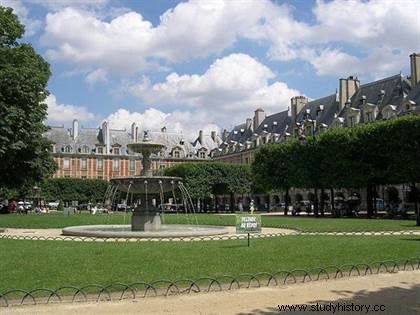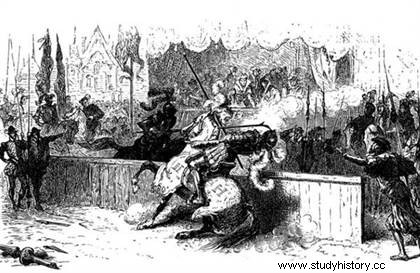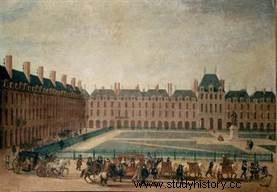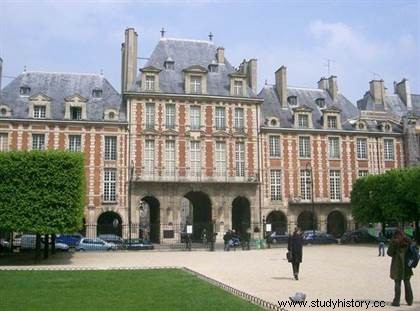 The Place des Vosges , in the Marais Parisien, former Place Royale is the most mythical and the oldest in Paris. It was a high place of festivals and tournaments until the death of Henri II in 1559. After this tragic accident, it was necessary to wait for the reign of Henri IV who made it again a magnificent place for walking and meeting. you of all kinds. Today it has been listed as a historical monument since 1954.
The Place des Vosges , in the Marais Parisien, former Place Royale is the most mythical and the oldest in Paris. It was a high place of festivals and tournaments until the death of Henri II in 1559. After this tragic accident, it was necessary to wait for the reign of Henri IV who made it again a magnificent place for walking and meeting. you of all kinds. Today it has been listed as a historical monument since 1954.
The Place des Vosges:a place of history
Originally, Pierre d'Orgemont, Chancellor of France, built in 1388 on the north side of the square, a vast house with a garden and surrounded by a wall lined with small towers, hence the name Hôtel des Tournelles or Maison Royale des Tournelles. It was both a citadel, a prison, but also a house in the fields.
 This Royal House had housed several kings and great figures:Louis d'Orléans in 1404, property of the king in 1417 , Charles VI, the Duke of Bedfort, Charles VII, Louis XI, Charles VII, Louis XII until his death in 1515, the Duchess of Etampes, François I, Cellini and the greatest Italian artists, Diane de Poitiers and finally Henri II who died there in 1559. It was the most beautiful time of the Royal House of Tournelles, the court was brilliant there, everyone bowed before the king, even the Guises and the Montmorencys. There were then only celebrations, jousts of love and wit until the unfortunate July 10, 1559 when Henry II was to die from a blow from a spear, which gouged out his eye and damaged his head.
This Royal House had housed several kings and great figures:Louis d'Orléans in 1404, property of the king in 1417 , Charles VI, the Duke of Bedfort, Charles VII, Louis XI, Charles VII, Louis XII until his death in 1515, the Duchess of Etampes, François I, Cellini and the greatest Italian artists, Diane de Poitiers and finally Henri II who died there in 1559. It was the most beautiful time of the Royal House of Tournelles, the court was brilliant there, everyone bowed before the king, even the Guises and the Montmorencys. There were then only celebrations, jousts of love and wit until the unfortunate July 10, 1559 when Henry II was to die from a blow from a spear, which gouged out his eye and damaged his head.
Catherine de Medici, disgusted by this place, left it to settle in the Louvre and ordered its entire demolition in 1563. This location was then used for a large horse market, alone means of transport at the time. At this place took place the famous duel of the minions of Henry III and the supporters of the Duke of Guise in April 1578, where all were killed or wounded.
In Paris, there was no longer an important place for parties and walks, so Henry IV decided in 1605 to transform the horse market into a magnificent square. The greatest artists of this time (Androuet, le Vau, Le Brun, Mignard) adopted a style close to that of the Renaissance with brick and slate.
First the King's Pavilion was built, to the south, then on this model, but less high, the other residences, resting on arcades forming the galleries, all made of bricks with borders and frames of white stone, the slate roofs surmounted by lead finials. The square was to have nine pavilions on each side, all with four arcades and two rows of four high windows per floor. The height of the facades is equal to their width and the height of the roofs is half that of the facades.
A very popular place of pleasure in the 17th century
This square gradually became a sought-after place for walks, rest, sheltered from the sun in summer and the rain in winter. In the middle of the square, we had sown grass and flowers, installed gushing waters. The statue of Louis XIII was built there in 1639 by Richelieu, with the following inscription:
 "To the glorious and immortal memory of the very great and very invincible Louis Le Juste, thirteenth of the name, king of France and Navarre. Armand, Cardinal and Duke of Richelieu, his prime minister in all his illustrious and generous designs, showered with honors and benefits by such a good master, had him erect this statue in testimony of his zeal, his obedience and his fidelity, 1639”.
"To the glorious and immortal memory of the very great and very invincible Louis Le Juste, thirteenth of the name, king of France and Navarre. Armand, Cardinal and Duke of Richelieu, his prime minister in all his illustrious and generous designs, showered with honors and benefits by such a good master, had him erect this statue in testimony of his zeal, his obedience and his fidelity, 1639”.
Henri IV, killed in 1610 will not see the completion of his work, the inauguration taking place in April 1612 on the occasion of two marriages:Louis XIII and Anne d Austria as well as Elisabeth of France (sister of the king) with the future Philippe IV. This time, no tournaments, but a magnificent party with a carousel, ballets where the gentlemen shone, dressed in their best clothes:1300 riders, 230 musicians, a torchlight procession and fireworks. A brilliant crowd circulated there. This great spectacle lasted two days.
From Place Royale to Place des Vosges
Since that day, Place Royale has become the fashionable residence of famous men and women, who have built many mansions decked out in red brick:Sully, Mr. de Guise, the son of Balafré, the Constable de Luynes, the Chancellor de Bellièvre, the Marshal de Brézé, Mr de Thou, the Marquis de Cinq-Mars, the cardinal's jester:Bois-Robert, Mr Tallemant des Réaux. Without forgetting Louis XIII, then Marion Delorme, Ninon de l'Enclos, the Princesses of Rohan and Guémenée, the Duchesses of Duras and Boufflers, Richelieu, the largest and most powerful salon in Europe:Scarron, Ménage , the Marquise de Rambouillet, Julie d'Argennes for whom the Garland of Julie was created, Mme de Sévigné, Mademoiselle de Scudéry, Molière, Corneille, Victor Hugo… and we forget many more…
In this unique meeting of fine minds and great lords, no name from the two reigns of Louis XIII and Louis XIV will be missing.
 At the storming of the Bastille, the inscription and the equestrian statue were demolished, but this will also be the end of the Marais. This square, transformed into a field of maneuver, was baptized Place des fédérés in 1792, and Place de l'Indivisibilité in 1793. It was only later that Napoleon gave it the name of Place des Vosges (in homage to the first department of the Vosges who paid his taxes).
At the storming of the Bastille, the inscription and the equestrian statue were demolished, but this will also be the end of the Marais. This square, transformed into a field of maneuver, was baptized Place des fédérés in 1792, and Place de l'Indivisibilité in 1793. It was only later that Napoleon gave it the name of Place des Vosges (in homage to the first department of the Vosges who paid his taxes).
At the Restoration in 1814, it resumed its name of Place Royale, which it had to abandon again in 1848. Currently, the old promenades of the Place des Vosges have become shopping malls:antiques, art bookstores, painting galleries, as well as some renowned restaurants and cafes. In the center of the square, the square Louis XIII, restored in the 19th century, is a very popular place for walking by Parisians.
The Great Known and Recognized
Walking around the square, we find, in addition to the kings of France, some old great names:
#1 was the King's flag. Next door, at n° 1 bis, Madame de Sévigné was born in 1626. The entrance to the Petit Hôtel de Sully is at n° 7 with a passage that communicates with the grand hotel rue Saint Antoine. Number 7 became the property of Sully in 1634.
At n° 9, Louis XIII stayed there during the celebrations inaugurating the Place Royale. Rachel the tragic actress lived on the 1st floor then at n° 11, Marion Delorme for nine years. The hotel had belonged to a branch of the Colberts and the last was Gilbert Colbert, Marquis de Chabannais.
Bossuet was a tenant at No. 17 for sixteen years. Number 21 is the hotel of Cardinal de Richelieu. Some claim that he did not live there! The Grand Duchess of Tuscany died there in 1721 and in 1877 Alphonse Daudet lived in the courtyard.
No. 23 was inhabited by Marie Touchet, then the sister of Henriette d'Entragues bought it in 1624. Passing through the hands of the bishop of Saintes, Louis II of Bassompierre, it was sold to the Hôtel Dieu. At number 25, the State Councilor Pierre du Quesnoy tried to burn down his mansion out of amorous spite for the future Madame de Montespan!

On the other side, at number 4, lived the Marquis de Favras in 1789, a marquis who was involved in the plot to kidnap Louis XVI and the assassination of LaFayette. Marshal de Lavardin lived at number 6 in the Hotel de Rohan-Guémené. This character was in the carriage of Henri IV when he was assassinated. Victor Hugo lived there for 16 years and then it was the Maison de Victor Hugo which became the Victor Hugo Museum.
N° 10 is the former Hôtel de Chatillon and at n° 18 that of the Clermont-Tonnerre family. A little further on, number 20 was the Hôtel d'Angennes in Rambouillet, where the famous marquise held a salon. Finally, we arrive at No. 28, the Queen's Pavilion, opposite No. 1, that of the King.
To go further
- From Place Royale to Place des Vosges, Alexandre Gady. AAP, 1997.
- Knowledge of Old Paris by Jacques Hillairet. Shores, 2005.
- The History of Paris, by Danielle Chadych, Dominique Leborgne. Gründ, 2010.
